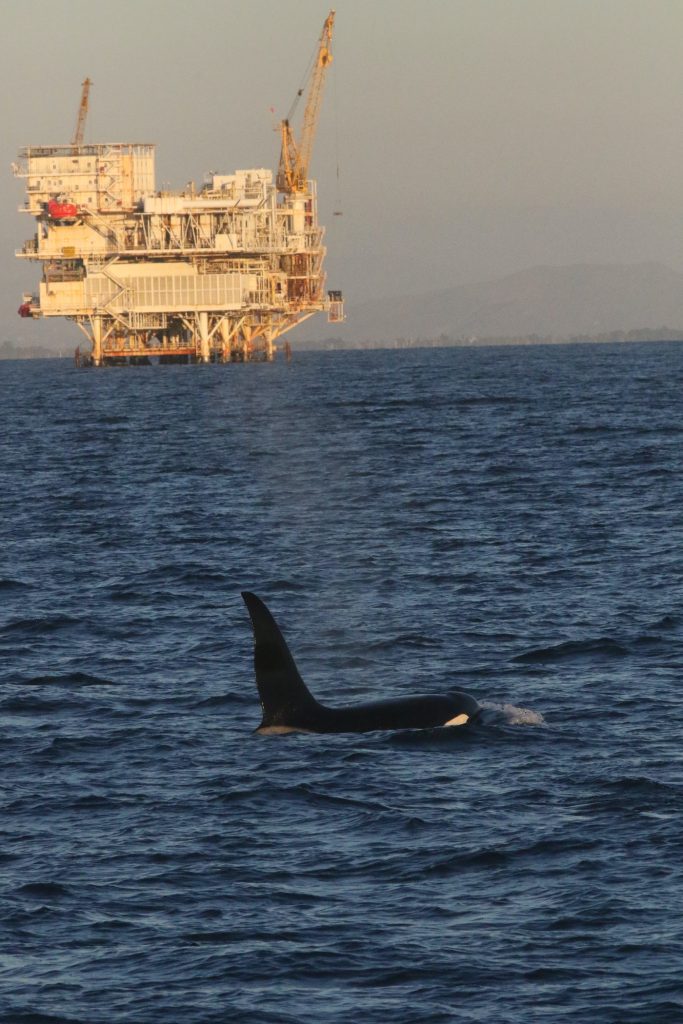Passing Through

There was no mistaking whose dorsal fin it belonged to. No physical characteristic in the marine mammal world can match the six-foot tall dorsal of a male orca. Its steeple-shaped fin sliced through the ocean like a submarine with its periscope up. Known as CA45B, a Bigg’s transient orca, he was enjoying himself on the eastern fringe of the Santa Barbara Channel. No one on the Island Packers ferry knew why at the time.
About 30 minutes earlier, just as I was boarding the ferry leaving Scorpion Anchorage on the southeast end of Santa Cruz Island, the word was a pod of orcas had been feeding on a common dolphin three hours prior. It was exciting to hear but knowing how much transient pods of orcas move around on their perpetual quest to find food, I wasn’t getting my hopes up. It was merely a chance and that was all anyone could ask for.
It was December 12, 2021, and the channel was glassy and smooth, a good day to spot wildlife. Standing on the upper deck of the Island Packers ferry, we were 30 minutes into our return to the Ventura Harbor, when Captain Luke and naturalist Holly Lohuis spotted a pod of orcas just west of oil platform Gail, but it wasn’t the pod spotted earlier in the day feeding on that unfortunate dolphin.
“We know a lot more than we did 40 years ago — primarily because of photo-identification studies of individuals, use of satellite tags, DNA samples, collaboration among researchers, citizen science effort,” said Alisa Schulman-Janiger, lead research biologist for the California Killer Whale Project, speaking on the sophistication of orcas. “Long-term studies are fascinating: each ecotype has their own unique culture. Since they live underwater and we can only observe what we see on the surface, we will never know everything about individuals that we cannot fully observe.”
After that first sighting of the male CA45B, there were a lot of moving parts in the channel. Orca experts from the California Orca Project later confirmed there were members from three separate pods converging on the pelagic scene. There was a lot of thrashing around, some tail flukes and rolling on the surface of a shimmering, late afternoon channel. During all that activity, there were three separate occasions where some of us observed the color pink. My initial reaction was they were feeding on something.
However, with members from three different pods around, any potential prey was steering clear of this region of the channel. There had been no sign of any dolphins, California sea lions, or whales nearby. So, what was all that pink? After the third sighting of pink in stark contrast to the black and white of the orcas, Captain Luke tapped on the window getting my attention. I spun around, and through the glass he revealed to me that CA45B was mating with a female from another pod. She is known as CA138B.
Now all that pink made sense regarding one of the most intelligent, sophisticated animals on the planet. However, orcas mating is rarely observed, and like much of their lives, there’s still much to learn about these apex predators of the deep blue.
“Mating is very rarely observed, as it almost always occurs underwater, nearly always out of our view,” said Shulman-Janiger. “Both of their matrilines are rarely seen. The CA45s and CA138s have only been documented together once (six years ago), when CA138B was a young juvenile. The only times they have been photographed together was on December 10 and December 12. No one knows how long these matrilines have been traveling together.”
Within the same vicinity was an equally rare sighting of the white orca affectionately known as “Frosty.” He’s a three-year-old male from the CA216s and is one of just a few orcas in the world documented with leucism.
Leucism is a term used to describe a variety of conditions that cause pigment loss in animals. For orcas it means they lose their black color. In the case of Frosty, he started out with a lighter, ashy-colored pigment, but over the first three years of his life, he has become mostly white, except with a dark outline around his eyepatch.
“There have been very few sightings of leucistic killer whales,” said Schulman-Janiger. “This is a very, very, rarely seen pigmentation anomaly; there is no way to know the cause strictly by appearance.”
Frosty swam closely to his mother, known as CA216C. Frosty hugged her left flank as they swam eastward west of oil platform Gail. The Santa Barbara Channel was shimmering and quiet, except for those orca spouts wafting skyward as the sun dropped behind Santa Cruz Island.
Chuck is a freelance writer and photographer based in Carpinteria, where he also leads kayak tours and backpacking trips in Channel Islands National Park





